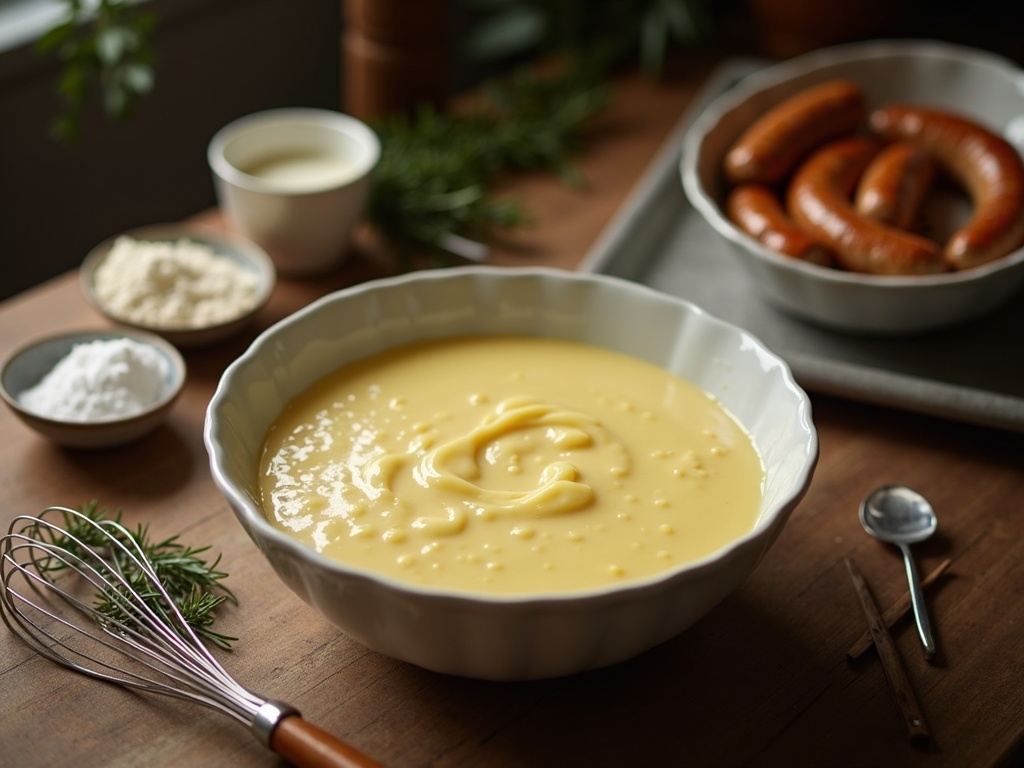Toad in the hole recipe combines crispy Yorkshire pudding batter with savory sausages for a quintessential British comfort food that dates back to the 18th century. This dish demands specific techniques—from creating a smooth, well-rested batter to managing temperature properly—which turns basic ingredients into a beautifully risen, golden-brown creation that’s economical and satisfying.
Find In This Article
Key Takeaways
- The perfect Yorkshire pudding batter requires thorough whisking of eggs, gradual incorporation of flour and milk, and a crucial 30-minute resting period.
- Maintaining a very hot oven (220°C/428°F) and preheating the oil until smoking are non-negotiable steps for achieving the dramatic rise in the batter.
- Never open the oven door during cooking as this causes the batter to collapse instantly.
- The dish can be adapted for various dietary needs using gluten-free flour alternatives or plant-based sausages without sacrificing flavor.
- Traditional accompaniments include rich onion gravy and seasonal vegetables, though modern twists incorporate different sausage varieties and additional ingredients for enhanced flavor.
I’ve found that making perfect toad in the hole requires attention to detail in both preparation and cooking. The batter must be perfectly smooth—I whisk eggs vigorously before adding flour and milk in stages. This method prevents lumps and creates the light texture essential for proper rising.
The 30-minute rest lets gluten develop and air bubbles form in the batter. I don’t rush this step because it significantly impacts the final texture. Meanwhile, I heat the oven thoroughly to 220°C and get the oil smoking hot before pouring in the batter. This immediate temperature shock creates that characteristic dramatic rise.
I’ve learned the hard way never to peek during cooking. Opening the oven door makes the batter deflate immediately, ruining the dish. Instead, I rely on timing and trust the process.
For dietary modifications, I substitute regular flour with gluten-free blends and traditional pork sausages with plant-based options. These changes maintain the dish’s essence while accommodating different needs.
The classic accompaniment is rich onion gravy, but I also serve it with seasonal vegetables for balance. Modern variations include using spiced sausages or adding herbs to the batter for added flavor dimensions.
The Perfect Yorkshire Pudding Batter
The secret to an exceptional toad in the hole lies in creating the perfect Yorkshire pudding batter. I’ve found that mixing the ingredients properly creates that crisp exterior while maintaining a soft, pillowy center that perfectly complements the savory sausages inside.
Essential Mixing Technique
To achieve a smooth, lump-free batter, I start by cracking eggs into a large mixing bowl and whisking them thoroughly until frothy. This aeration is crucial for creating that signature rise. Next, I gradually add sifted plain flour and a pinch of salt while continuously whisking. The slow addition prevents lumps from forming. Finally, I pour in milk bit by bit, incorporating it completely before adding more. The end result should have a consistency similar to single cream – thin enough to pour easily but thick enough to coat the back of a spoon.
If you’re struggling with lumps despite your best efforts, try these troubleshooting steps:
- Pour the batter through a fine sieve to catch any remaining lumps
- Use room temperature ingredients for better incorporation
- Consider using an electric whisk for more thorough mixing
- Add a tablespoon of cold water if the batter seems too thick
The Crucial Resting Period
After mixing, I always let my Yorkshire pudding batter rest for at least 30 minutes at room temperature. This resting period isn’t just traditional – it’s functional. It allows the gluten in the flour to relax, resulting in a lighter, more tender pudding. The starch molecules also have time to absorb the liquid, which helps create that perfect rise when the cold batter hits the hot oil.
If you’re short on time, 15 minutes of resting will do in a pinch, but I’ve found that a full 30 minutes produces noticeably better results. The entire preparation process takes about 15 minutes of active work, plus the 30-minute resting time.
Right before pouring the batter into your hot pan with browned sausages, give it one final quick whisk to reincorporate any ingredients that may have separated during the rest. This extra step ensures your toad in the hole will puff up beautifully around the sausages, creating that stunning contrast between crisp edges and soft center that makes this classic sausage dish so irresistible.
Essential Cooking Techniques for Success Toad In The Hole Recipe
Getting your toad in the hole just right requires attention to a few critical techniques. I’ve perfected these steps over years of cooking this classic British dish, and they make all the difference between a disappointingly flat batter and a gloriously risen golden masterpiece.
Key Temperature and Timing Tips
Preheating your oven to exactly 220°C (428°F) is non-negotiable for this recipe. The intense heat creates the dramatic rise in the Yorkshire pudding batter that surrounds the sausages. Before adding any ingredients, I place the baking dish with about 2 tablespoons of oil in the hot oven until it’s smoking hot – this typically takes about 5-7 minutes. This step is crucial for creating that crispy exterior.
When preparing the sausages, I always brown them first for about 10 minutes. This technique achieves two things: it locks in the juices and adds a deeper flavor to the sausage base before it meets the batter.
The total cooking time runs between 30-40 minutes, depending on your oven. You’ll know it’s ready when the batter has puffed up dramatically and turned a rich golden brown color.
Here are the absolute must-follow rules for perfect results:
- Never, ever open the oven door during cooking – this causes the batter to collapse instantly
- Make sure your oil is properly smoking hot before adding the batter
- Pour the batter quickly around the browned sausages
- Allow the finished dish to rest for 3-5 minutes before serving
- This recipe perfectly serves 4 people using 8 quality sausages
The dramatic puff of the Yorkshire pudding batter is similar to what you might achieve with homemade sausage rolls, requiring that same careful temperature control. For an extra twist, I sometimes add herbs like thyme or rosemary to the batter, which complements the savory sausages beautifully.
If you’re feeding a larger crowd, resist the urge to make one giant toad in the hole – instead, prepare two medium-sized ones. The batter rises more reliably, and you’ll avoid the dreaded soggy center that can happen with oversized portions. This approach gives you consistent results that would pair wonderfully with cauliflower cheese as a side dish for a true British comfort food feast.

A Classic British Comfort Food
Toad in the hole has been warming British hearts and stomachs since the 18th century. I’ve always found this dish to be the perfect example of British ingenuity – transforming simple ingredients into something truly special. The peculiar name comes from the appearance of sausages poking through the batter, resembling toads peeking out from their holes in the Yorkshire pudding batter.
History and Origins
This dish first appeared in British cookbooks around the 1760s, though the original version was quite different from what we know today. Initially, it wasn’t made specifically with sausages but rather used any leftover meat. The resourcefulness of British cooks during times of scarcity led to this creative use of ingredients. By the Victorian era, toad in the hole had evolved into the sausage-based dish we recognize today.
The dish became increasingly popular during wartime when meat was scarce and families needed to make the most of their rations. Its staying power speaks to both its deliciousness and practicality – a hearty meal from minimal ingredients.
Cultural Significance
In British cuisine, toad in the hole holds a special place alongside other comfort food classics. It’s a dish that represents home cooking at its best – unfussy, satisfying, and perfect for gathering the family around the table. The following aspects make it culturally significant:
- Regional variations exist throughout Britain, with some areas preferring Cumberland sausages while others opt for Lincolnshire or traditional pork sausages
- Often served at Sunday lunches alongside traditional sides
- Featured in British school dinners for generations
- Celebrated in food festivals and country pubs across the UK
- Represents the British knack for creating memorable names for simple dishes
I’ve noticed toad in the hole has experienced a revival in recent years, with gastro-pubs and celebrity chefs putting modern spins on this classic. Despite these fancy updates, the soul of the dish remains unchanged – a crispy Yorkshire pudding batter surrounding juicy sausages cooked to perfection.
Traditionally, toad in the hole is served with rich onion gravy poured over the top, alongside seasonal vegetables like peas, carrots, or cabbage. Some families have their own signature sides – my personal favorite accompaniment is a side of creamy cauliflower cheese which adds another layer of comfort to this already hearty meal.
What makes this dish particularly special is its ability to bring people together. There’s something magical about pulling a golden-brown toad in the hole from the oven, watching as the puffed batter slowly deflates, and hearing the appreciative sounds from hungry diners around the table.
Many British families have their own sausage recipe variations, passed down through generations. Some add herbs to the batter, others incorporate mustard, and some brave souls even experiment with different types of sausages for unique flavor combinations.
Whether you’re a Brit longing for a taste of home or someone curious about international comfort foods, toad in the hole represents British cuisine at its most authentic. It’s unpretentious, satisfying, and carries with it centuries of culinary history. Unlike fancier dishes that come and go with culinary trends, toad in the hole has maintained its beloved status on British dinner tables for generations – a true testament to its enduring appeal.

Know Your Nutritional Facts
I’ve calculated that a traditional toad in the hole serving contains approximately 350-400 calories, making it a reasonably balanced main course option for most meals. The nutritional breakdown shows about 25g of protein per serving, which comes primarily from the sausages, while the batter contributes around 30g of carbohydrates. The fat content averages 20g per serving, with most coming from the meat and any oil used during preparation.
Adapting for Dietary Needs
Toad in the hole can be easily modified to suit various dietary requirements without sacrificing flavor or texture. For those following a gluten-free diet, I’ve found several excellent flour alternatives that work wonderfully in the batter:
- Rice flour creates a light, crispy batter that browns beautifully.
- Chickpea flour adds a nutty flavor and extra protein.
- A pre-mixed gluten-free flour blend often produces results closest to traditional wheat flour.
The dish can also be adapted for plant-based diets with excellent results. Modern meat alternatives have come a long way in mimicking the texture and flavor of traditional sausages. I’ve tested several plant-based sausage options that hold up well during baking and provide a similar protein content to meat versions.
For those watching their fat intake, using leaner sausage varieties can reduce the overall fat content while maintaining flavor. Turkey or chicken sausages typically contain about half the fat of pork alternatives, bringing the total fat content down to around 12-15g per serving.
The egg content in the batter provides additional protein and healthy fats. For those with egg allergies, commercial egg replacers work surprisingly well in this recipe, though the batter may not rise quite as dramatically.
The beauty of sausage-based dishes like toad in the hole is their versatility. By adjusting ingredients and cooking methods, I can create versions suitable for nearly any dietary preference or restriction while maintaining the comforting appeal of this classic dish.
Adding vegetables to the batter or serving them alongside increases the nutritional profile dramatically. A side of steamed greens or roasted vegetables boosts the fiber, vitamin, and mineral content, creating a more nutritionally complete meal. For a one-dish approach, I sometimes add caramelized onions or sautéed mushrooms directly to the batter before baking.
While traditional sausage recipes often include breadcrumbs as fillers, many quality options now focus on higher meat content and fewer fillers, improving the protein-to-carbohydrate ratio. When making this dish, selecting high-quality sausages with defined ingredient lists makes a significant difference to both the flavor and nutritional profile.

Modern Twists on Tradition
Traditional toad in the hole has evolved beyond its humble beginnings, with creative cooks finding exciting ways to enhance this British classic. I’ve discovered that adding vegetables not only brings color to the dish but also provides more nutritional value and flavor complexity.
Vegetable Additions and Sausage Variations
Adding vegetables to the classic recipe transforms it into a more complete meal. I often tuck these into the batter before baking:
- Caramelized onions for sweetness and depth
- Sliced bell peppers for color and vitamin C
- Cherry tomatoes for bursts of acidity
- Sautéed mushrooms for an earthy flavor profile
The sausage selection itself offers endless possibilities for personalization. The traditional pork sausages can be swapped for chicken, beef, or lamb varieties. For those seeking bolder flavors, try chorizo for a smoky-spicy kick or herb-infused chicken sausages for a lighter option. Vegetarian sausages have also become a popular alternative, making this dish accessible to more dietary preferences.
Global Inspirations
This concept of meat baked in batter appears in many culinary traditions. The French Saucisse en Croûte wraps sausages in pastry rather than batter, creating a crispier exterior. Similarly, American “pigs in blankets” offer a bite-sized variation. These international cousins to toad in the hole show how the basic concept resonates across cultures.
Fusion versions have gained popularity, reflecting our increasingly global palate. Asian-inspired versions might incorporate five-spice into the batter or use curried sausages for heat. Mediterranean variations often include herbs like rosemary and thyme in the batter, paired with roasted vegetables for a complete one-pan meal.
The batter itself has become a canvas for experimentation. Adding whole grain mustard creates a tangy kick, while beer batter offers depth and fluffiness. Some cooks even incorporate cheese into the mixture, creating a savory, rich base that complements the sausages beautifully.
For a heartier meal, transforming toad in the hole into a complete casserole by adding a layer of beans or lentils beneath the sausages creates a protein-packed dinner. Finishing with a sweet twist, some innovative cooks have created dessert versions similar to bread pudding, using fruit instead of sausages and serving with custard.

Perfect Pairings and Serving
A classic toad in the hole deserves perfect accompaniments to elevate it from a simple dish to a memorable meal. I’ve discovered through years of cooking that certain pairings create that quintessential British dining experience that makes this dish so beloved.
Classic Accompaniments
Onion gravy is the traditional and arguably essential companion to toad in the hole. The rich, savory sauce provides moisture and flavor that perfectly complements both the sausages and the crispy batter. I create mine by slowly caramelizing onions until deeply golden, then adding stock, herbs, and a touch of flour for thickening. This results in a silky gravy that clings beautifully to each portion.
Seasonal vegetables add color, nutrition, and balance to this hearty dish. I recommend these options depending on the time of year:
- Spring/Summer: Tender green beans, fresh peas, or steamed asparagus
- Autumn/Winter: Roasted carrots, buttered cabbage, or cauliflower cheese for extra indulgence
- Year-round: Mashed potatoes, garden peas, or a simple green salad
For something a bit different, curried sausages inspiration can add interesting flavor profiles to your gravy with warm spices like cumin and coriander.
Selecting Quality Ingredients
The sausages are undoubtedly the star of toad in the hole, making their selection particularly important. High-quality, flavorful sausages with a good meat content make all the difference in the final dish. I opt for traditional Cumberland or Lincolnshire varieties with their distinctive herb and pepper profiles, but any good quality sausage suitable for casseroles will work beautifully.
For a twist on the classic, try different sausage varieties like:
- Pork and apple
- Toulouse-style with garlic
- Chicken and herb for a lighter option
- Lamb and mint for something unique
The batter itself is similar to what you’d use for bread and butter pudding, though savory rather than sweet – eggs, flour, and milk combined into a smooth consistency.
Serving toad in the hole requires careful timing. I bring it directly from oven to table while still puffed and crisp. The dramatic appearance of the risen batter is part of the appeal, and this visual impact diminishes quickly as it cools. Have your gravy ready, sides prepared, and the table set before removing your masterpiece from the oven.
Family-style serving works best – place the entire dish in the center of the table for everyone to admire before portioning. For more formal occasions, pre-cut portions in the kitchen and arrange them with gravy and sides for a more elegant presentation.
When entertaining, consider serving smaller individual portions as a starter, similar to how you might present sausage rolls or offer it alongside chicken and mushroom pie for a British comfort food feast.
This versatile dish transitions seamlessly from casual family dinner to dinner party centerpiece, especially when attention is paid to quality ingredients and thoughtful serving. The key is serving immediately while hot, with ample gravy and complementary sides to create a complete and satisfying meal.

Sources:
Traditional British Toad in the Hole – A Renowned Recipe
Nutritional Analysis of Common British Dishes
History and Evolution of British Cuisine

